Pulse Current of Multi-Needle Negative Corona Discharge and Its Electromagnetic Radiation Characteristics
Abstract
:1. Introduction
2. Experimental Setup
3. Experimental Results and Analysis
3.1. Single-Needle Negative Corona Discharge Trichel Pulse Current and Its Radiation Characteristics
3.2. Multi-Needle Negative Corona Discharge Characteristics
4. Discussion
4.1. Mechanism Analysis of EM Radiation Generated by Negative Corona Discharge
4.2. Comparison of Calculation Results of Dipole Radiation Model with Experimental Test Results
4.3. Effects of Multi-Needle Discharge Structure on EM Radiation Characteristics of Negative Corona Discharge
5. Conclusions
Author Contributions
Funding
Conflicts of Interest
References
- Rycroft, M.J. Gas discharge physics. J. Atmos. Terr. Phys. 1993, 55, 1487. [Google Scholar] [CrossRef]
- Dau, V.T.; Dinh, T.; Tran, C.D.; Terebessy, T.; Bui, T.T. Dual-pin electrohydrodynamic generator driven by alternating current. Exp. Therm. Fluid Sci. 2018, 97, 290–295. [Google Scholar] [CrossRef]
- Dong, S.; Li, J.; Kim, M.H.; Cho, J.; Park, S.J.; Nguyen, T.H.; Eden, J.G. Deactivation of Legionella Pneumophila in municipal wastewater by ozone generated in arrays of microchannel plasmas. J. Phys. D Appl. Phys. 2018, 51, 255501. [Google Scholar] [CrossRef] [Green Version]
- Arif, S.; Branken, D.J.; Everson, R.C.; Neomagus, H.W.J.P.; le Grange, L.A.; Arif, A. CFD modeling of particle charging and collection in electrostatic precipitators. J. Electrost. 2016, 84, 10–22. [Google Scholar] [CrossRef]
- Jaworek, A.; Marchewicz, A.; Sobczyk, A.T.; Krupa, A.; Czech, T. Two-stage electrostatic precipitator with dual-corona particle precharger for PM2.5 particles removal. J. Clean. Prod. 2017, 164, 1645–1664. [Google Scholar] [CrossRef]
- Terrab, H.; Kara, A. Parameters design optimization of 230 kV corona ring based on electric field analysis and response surface methodology. Electr. Power Syst. Res. 2018, 163, 782–788. [Google Scholar] [CrossRef]
- Tanner, R.L.; Nanevicz, J.E. An Analysis of Corona-Generated Interference in Aircraft. Proc. IEEE 1964, 52, 44–52. [Google Scholar] [CrossRef]
- Abdel-Salam, M.; Hashem, A.; Sidique, E. Characteristics of negative corona discharge in single-needle- and multi-needle-to-plane configurations. Int. J. Plasma Environ. Sci. Technol. 2013, 7, 121–135. [Google Scholar]
- Thanh, L.C. Negative Corona in a Multiple Interacting Point-to-Plane Gap in Air. IEEE Trans. Ind. Appl. 1985, IA-21, 518–522. [Google Scholar] [CrossRef]
- Jaworek, A.; Krupa, A. Electrical characteristics of a corona discharge reactor of multipoint-to-plane geometry. Czechoslov. J. Phys. 1995, 45, 1035–1047. [Google Scholar] [CrossRef]
- Trichel, G.W. The mechanism of the negative point to plane corona near onset. Phys. Rev. 1938, 54, 1078–1084. [Google Scholar] [CrossRef]
- Fernando, S.C. Electromagnetic Radiation due to Partial Discharge and Fault Detection Method for Overhead Distribution Lines. Ph.D. Thesis, RMIT University, Melbourne, Australia, 2012; pp. 1–118. [Google Scholar]
- Zhang, L.; Han, X.; Li, J. Partial discharge detection and analysis of needle-plane defect in SF6 under negative oscillating lightning impulse voltage based on UHF method. IEEE Trans. Dielectr. Electr. Insul. 2017, 24, 296–303. [Google Scholar] [CrossRef]
- Reid, A.J.; Judd, M.D.; Stewart, B.G.; Fouracre, R.A. Frequency distribution of RF energy from PD sources and its application in combined RF and IEC60270 measurements. In Proceedings of the 2006 IEEE Conference on Electrical Insulation and Dielectric Phenomena, Kansas City, MO, USA, 15–18 October 2006; pp. 640–643. [Google Scholar] [CrossRef]
- Mutakamihigashi, T.; Kuroishi, Y.; Ueno, H. Polarity effect and electromagnetic radiation of partial discharge accompanying growth of electrical tree. Electr. Eng. Jpn. 2015, 192, 19–26. [Google Scholar] [CrossRef]
- Nugraha, F.A.; Harid, N.; Barkat, B.; Al Sayari, N.; Jayaram, S.; Griffiths, H. Analysis of partial discharge in air using emitted electromagnetic waves and the HFCT method. In Proceedings of the 2016 IEEE Electrical Insulation Conference (EIC), Montreal, QC, Canada, 19–22 June 2016; pp. 551–554. [Google Scholar] [CrossRef]
- IEC-62478. High-Voltage Test Techniques—Measurement of Partial Discharges by Electromagnetic and Acoustic Methods. Proposed Horizontal Standard, 1st ed.; International Electrotechnical Commission (IEC): Geneva, Switzerland, 2016; submitted. [Google Scholar]
- Tungkanawanich, A.; Kawasaki, Z.I.; Abe, J.; Matsuura, K. Location of partial discharge source on distribution line by measuring emitted pulse-train electromagnetic waves. In Proceedings of the 2000 IEEE Power Engineering Society Winter Meeting, Conference Proceedings (Cat. No. 00CH37077), Singapore, 23–27 January 2000; Volume 4, pp. 2453–2458. [Google Scholar] [CrossRef]
- Tsutsumi, Y.; Ono, K.; Fujii, K.; Higaki, M. Electromagnetic noise spectra of corona discharge at point-to-plane electrodes in air. IEEJ Trans. Fundam. Mater. 2008, 111, 733–740. [Google Scholar] [CrossRef]
- He, W.; Chen, X.; Wan, B.; Lan, L.; Fu, W.; Guo, H.; Wen, X. Characteristics of Alternating Current Corona Discharge Pulses and Its Radio Interference Level in a Coaxial Wire-Cylinder Gap. IEEE Trans. Plasma Sci. 2018, 46, 598–605. [Google Scholar] [CrossRef]
- Zhang, Y.; Liu, L.; Miao, J.S.; Peng, Z.L.; Ouyang, J.T. Trichel pulse in negative DC corona discharge and its electromagnetic radiations. J. Electr. Eng. Technol. 2015, 10, 1174–1180. [Google Scholar] [CrossRef]
- Lama, W.L.; Gallo, C.F. Interaction of the “trichel” current pulses of a pair of negative coronas. J. Phys. D. Appl. Phys. 1973, 6, 1963–1972. [Google Scholar] [CrossRef]
- Ricardo Albarracín, S. Medida de Descargas Parciales en Radiofrecuencia. Ph.D. Thesis, Departamento de Ingeniería Eléctrica, Universidad Carlos III de Madrid, Getafe, Spain, 2014. [Google Scholar]
- IEC-60270. High-Voltage Test Techniques—Partial Discharge Measurements, 3rd ed.; International Electrotechnical Commission (IEC): New Delhi, India, 2000. [Google Scholar]
- Loeb, L.B.; Kip, A.F.; Hudson, G.G.; Bennett, W.H. Pulses in negative point-to-plane corona. Phys. Rev. 1941, 60, 714–722. [Google Scholar] [CrossRef]
- Lama, W.L.; Gallo, C.F. Systematic study of the electrical characteristics of the “trichel” current pulses from negative needle-to-plane coronas. J. Appl. Phys. 1974, 45, 103–113. [Google Scholar] [CrossRef]
- Dordizadeh, P.; Adamiak, K.; Castle, G.P. Experimental study of the characteristics of Trichel pulses in the needle-plane negative corona discharge in atmospheric air. J. Electrostat. 2017, 88, 49–54. [Google Scholar] [CrossRef]
- Chen, J.; Davidson, J.H. Model of the Negative DC Corona Plasma: Comparison to the Positive DC Corona Plasma. Plasma Chem. Plasma Process. 2003, 23, 83–102. [Google Scholar] [CrossRef]
- Nath, D.; Kumar, U. Total electric field due to an isolated electron avalanche. IEEE Trans. Dielectr. Electr. Insul. 2016, 23, 2562–2571. [Google Scholar] [CrossRef]
- Cooray, V.; Cooray, G. Electromagnetic radiation field of an electron avalanche. Atmos. Res. 2012, 117, 18–27. [Google Scholar] [CrossRef]
- Wilson, P.F.; Ma, M.T. Fields Radiated by Electrostatic Discharges. IEEE Trans. Electromagn. Compat. 1991, 33, 10–18. [Google Scholar] [CrossRef]
- Colver, G.M.; El-Khabiry, S. Modeling of DC corona discharge along an electrically conductive flat plate with gas flow. IEEE Trans. Ind. Appl. 1999, 35, 387–394. [Google Scholar] [CrossRef]



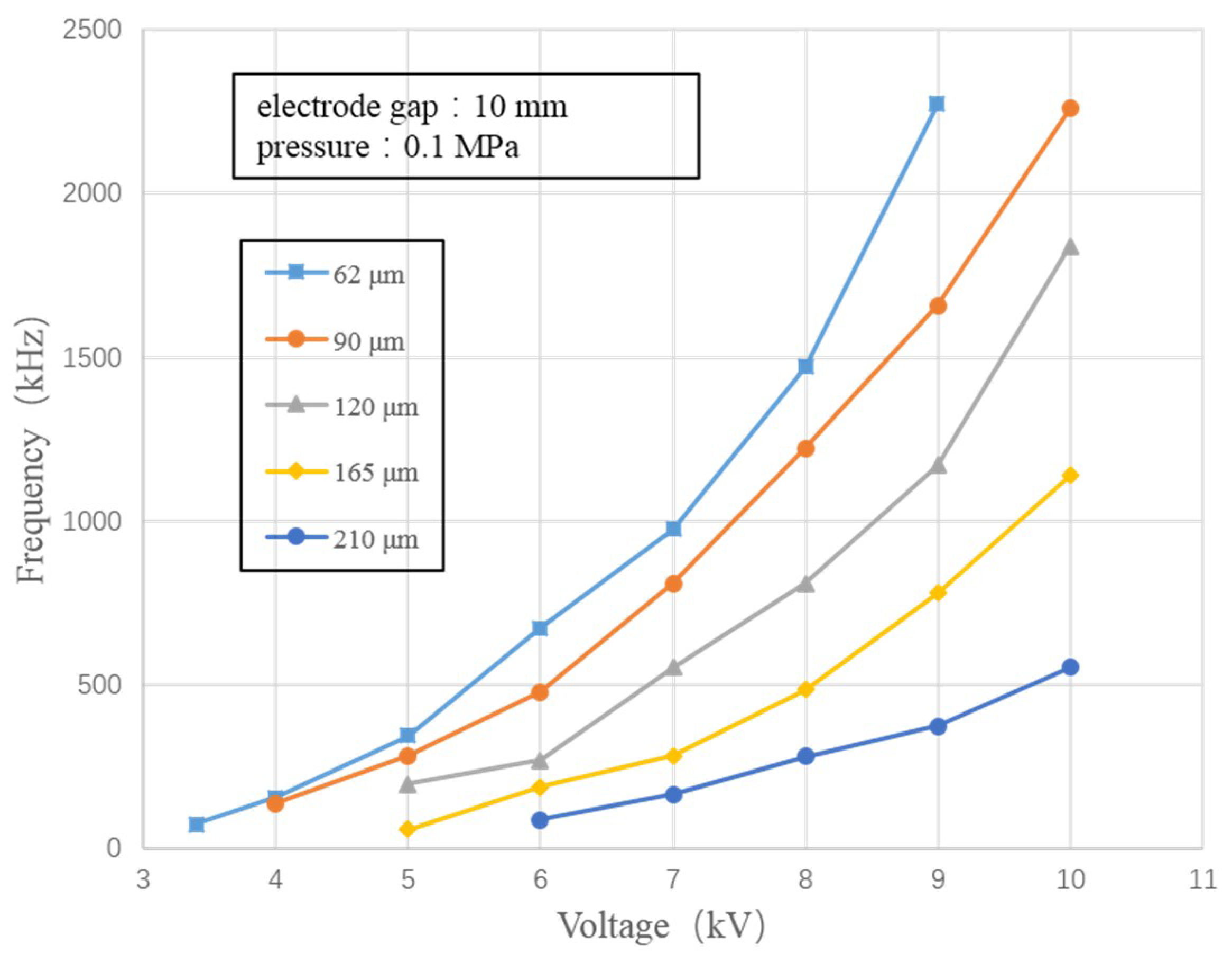
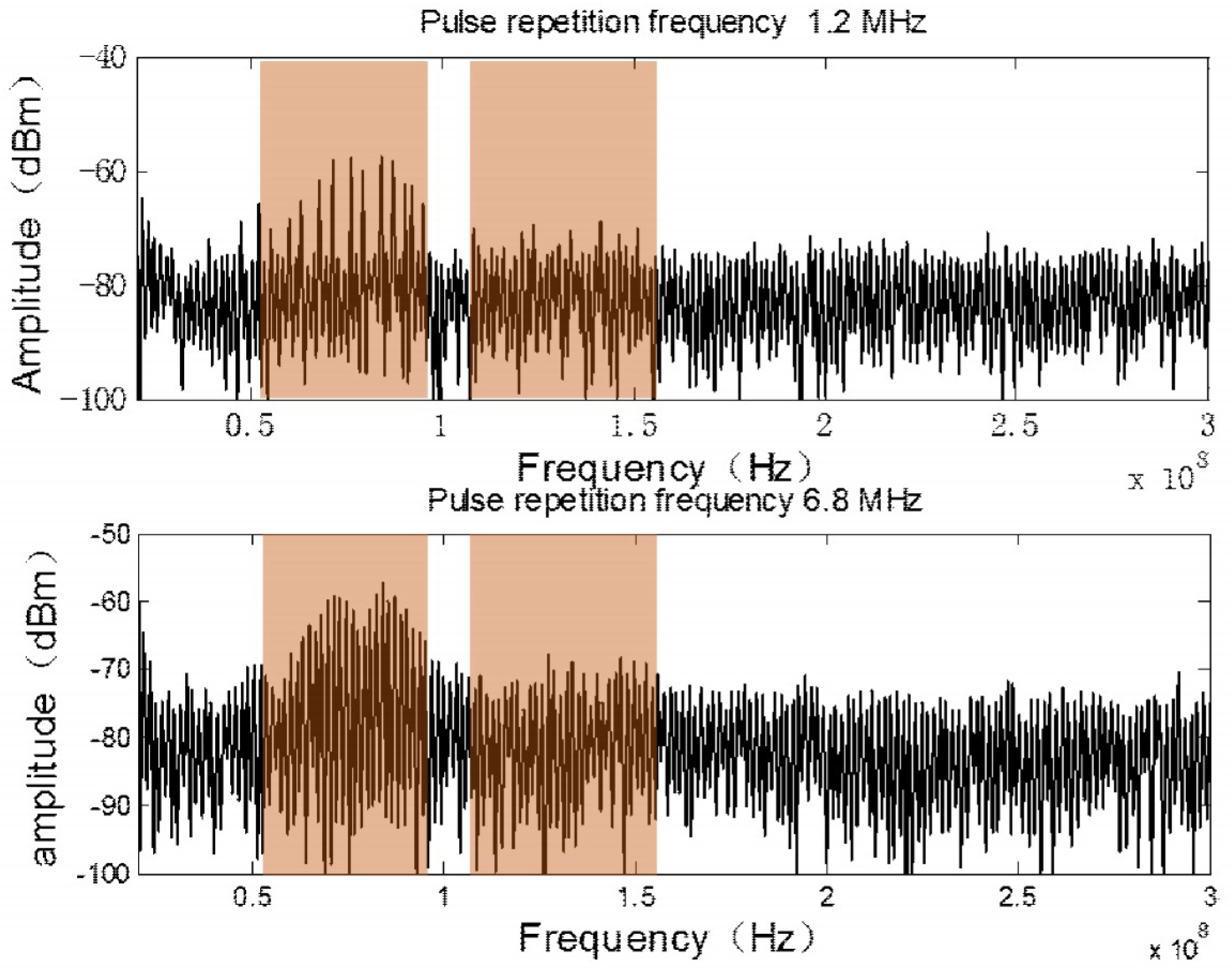

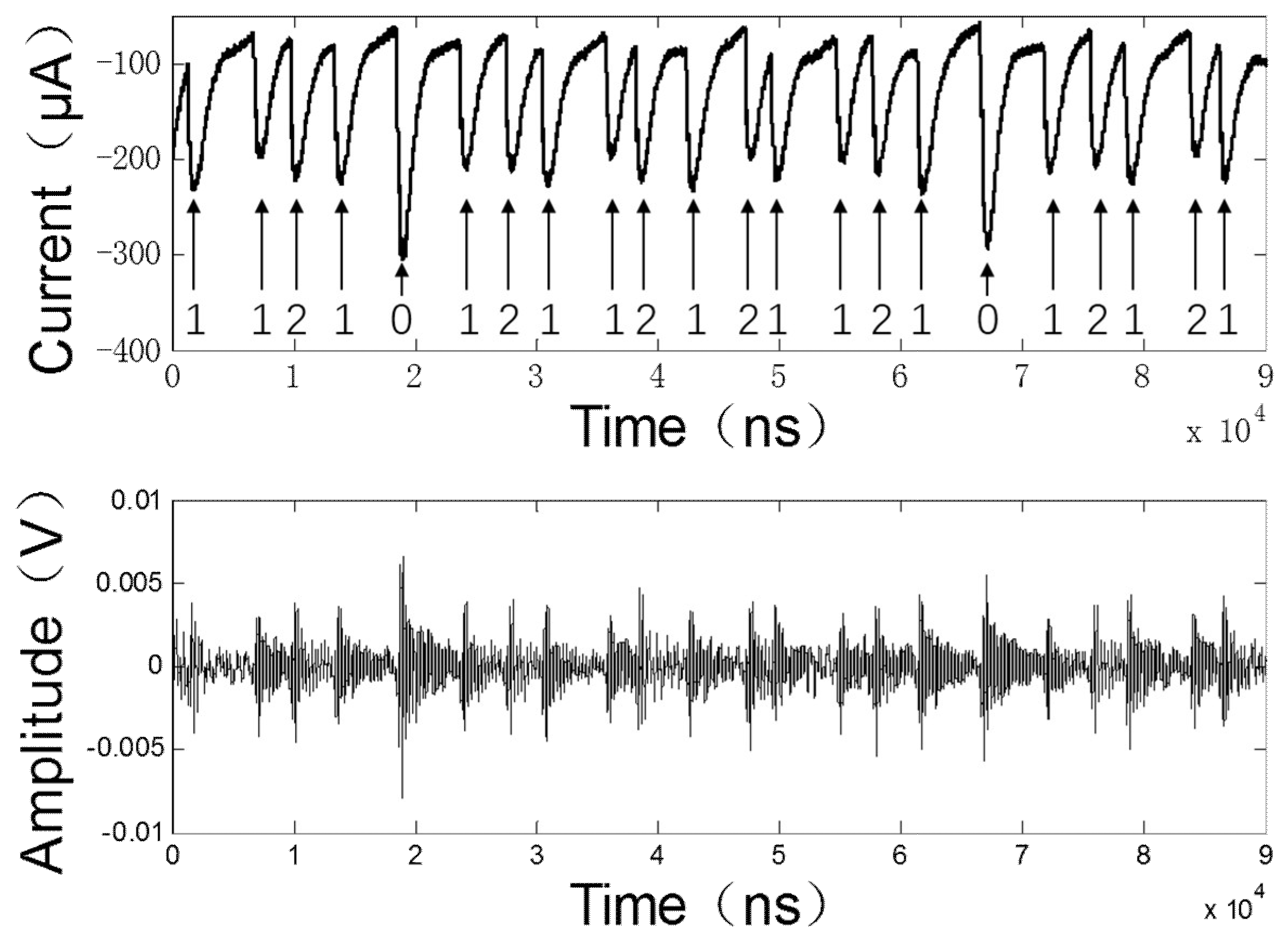
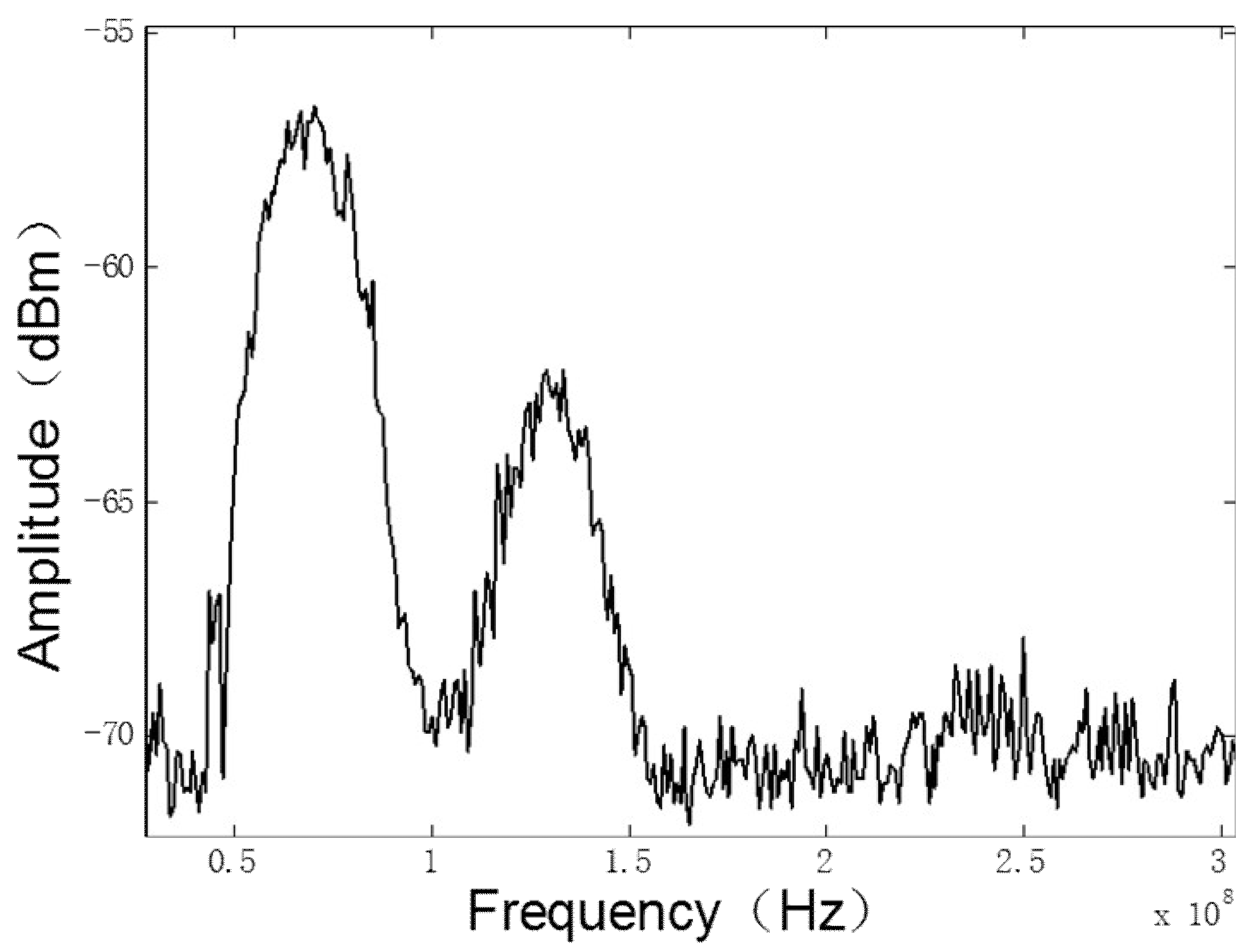
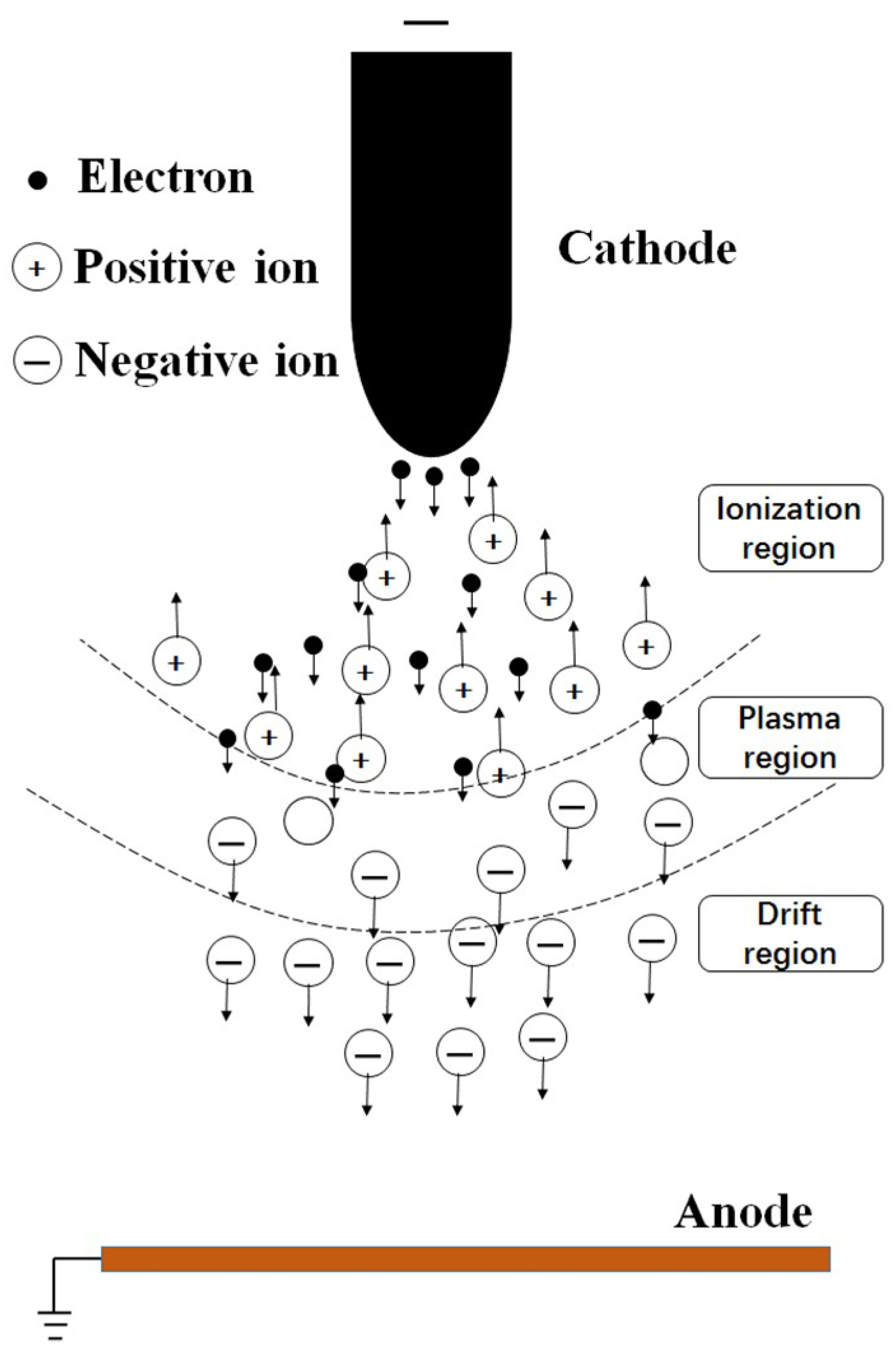
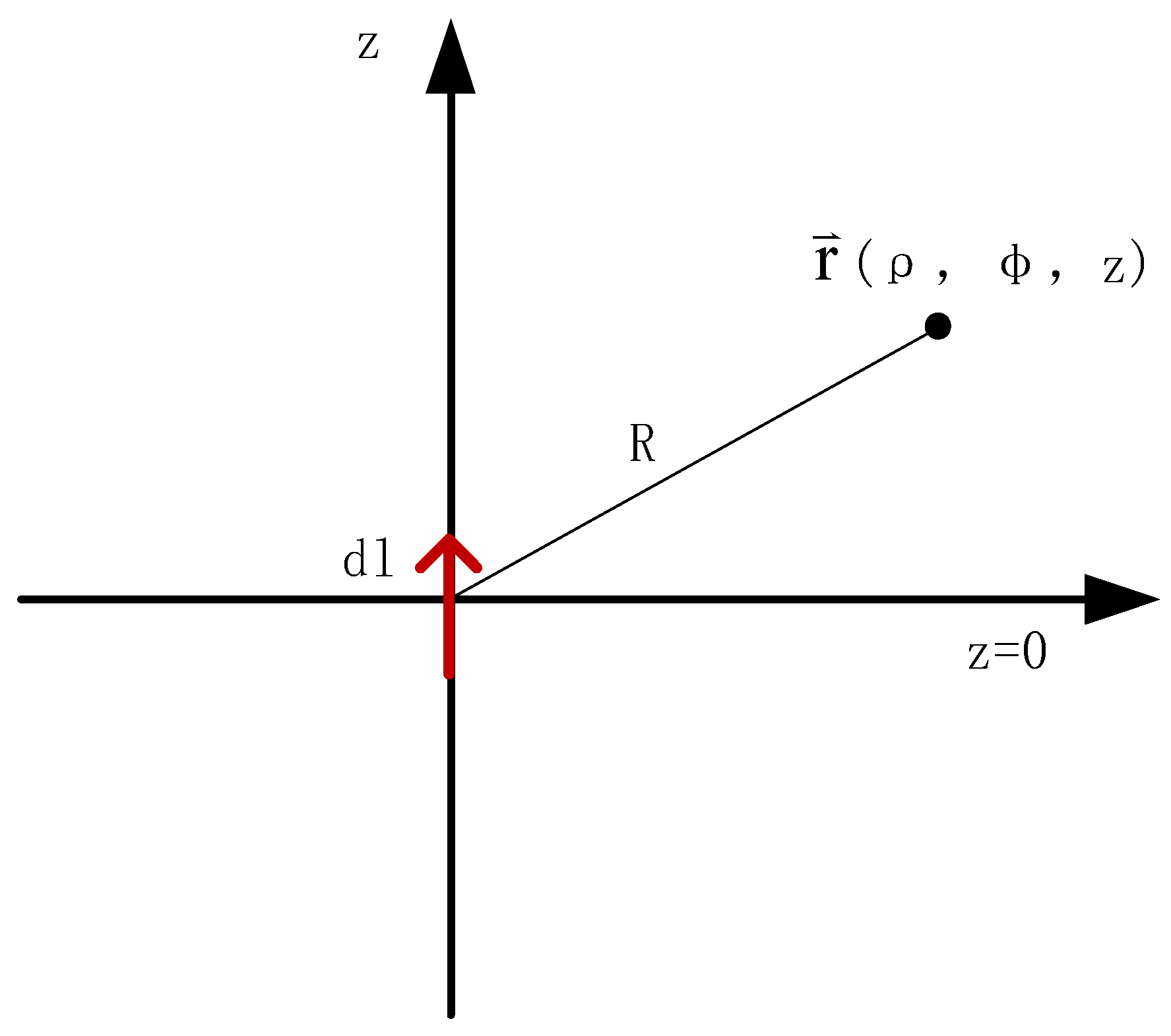
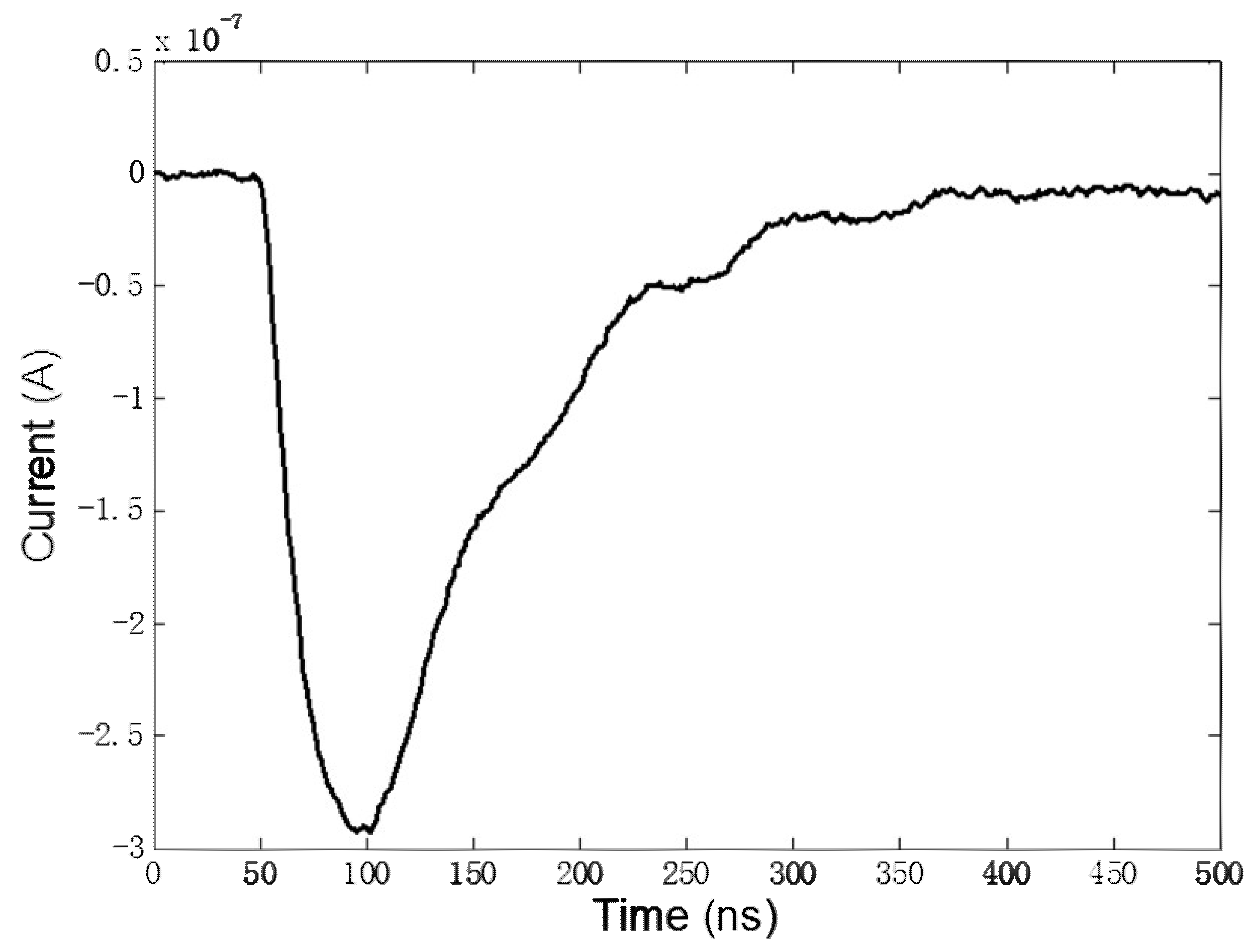


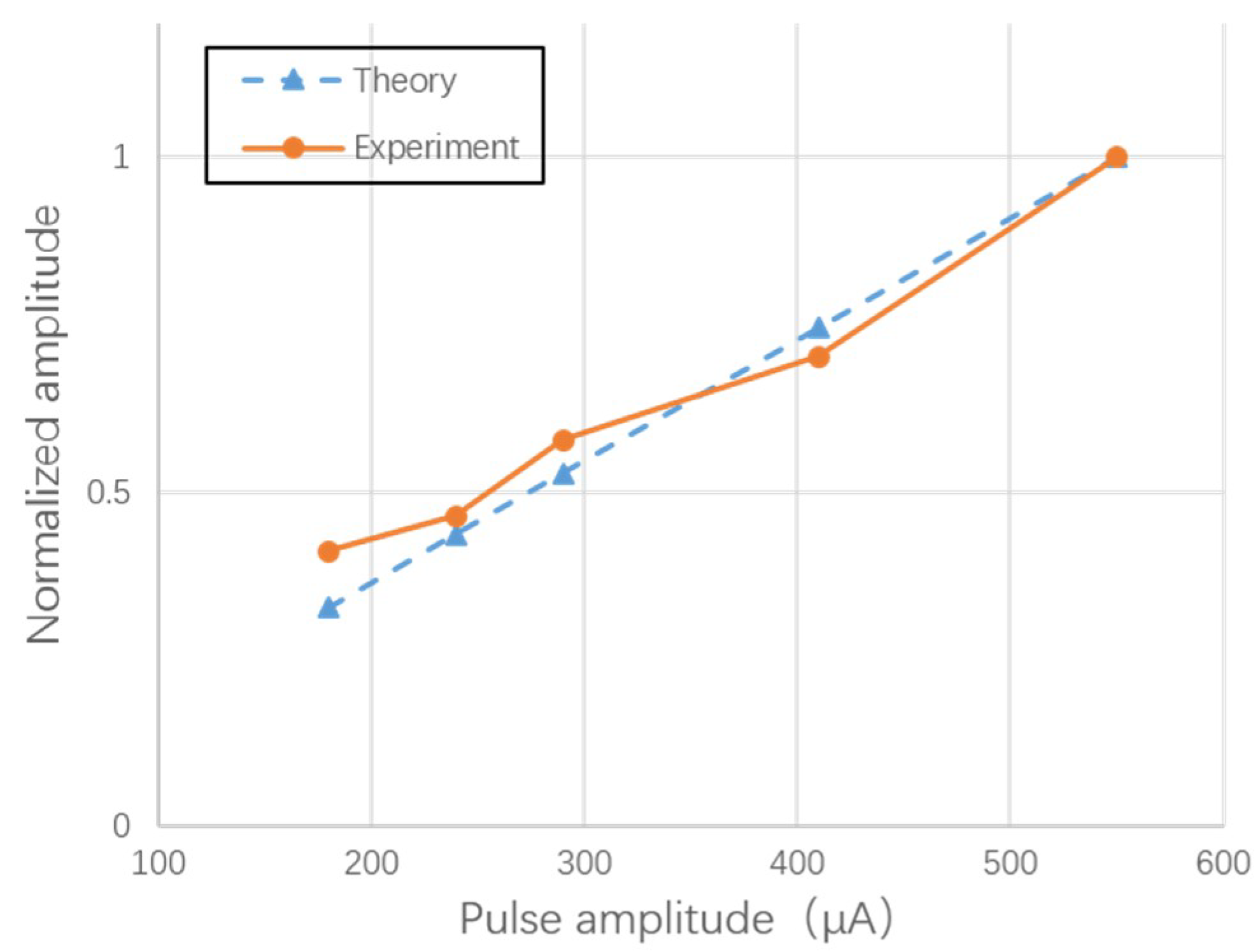
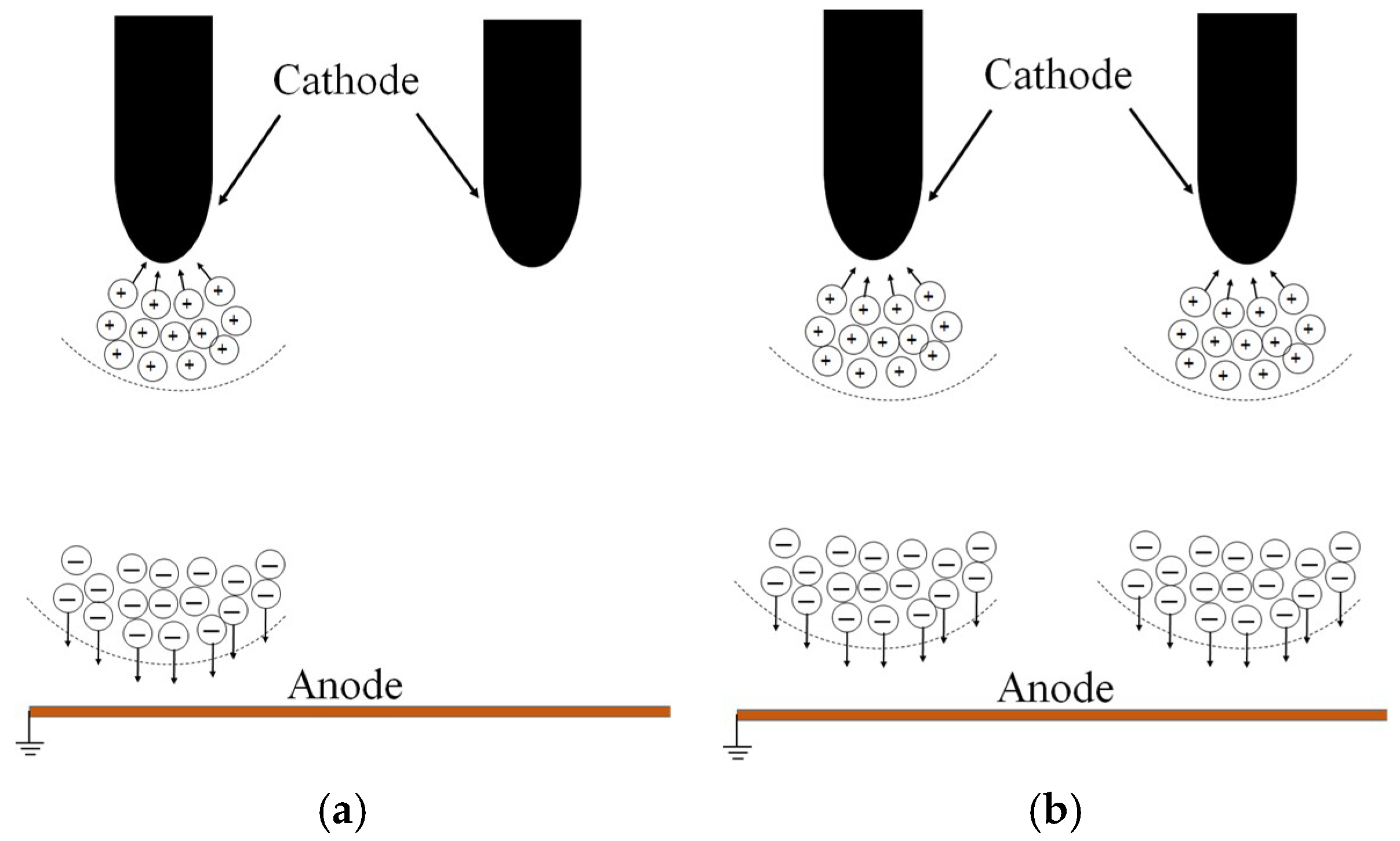
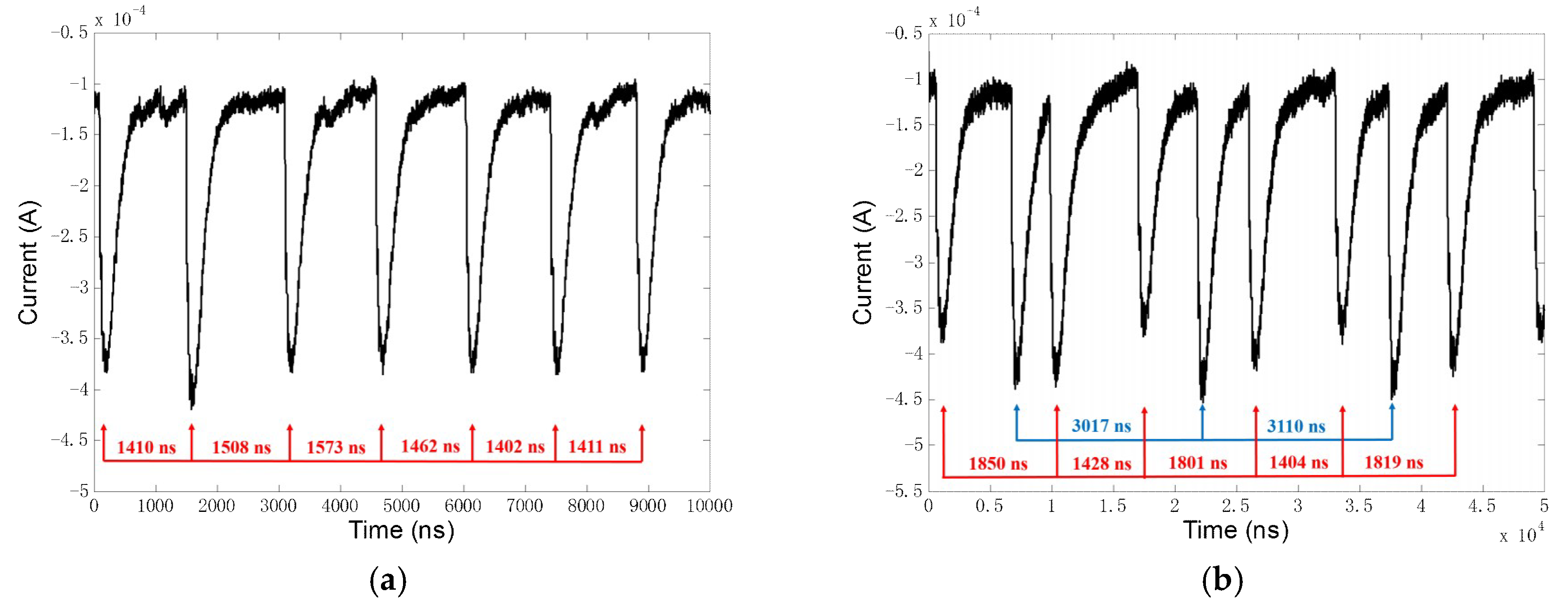
| Tip Radius (μm) | Air Pressure (MPa) | Pules Amplitude (μA) | Rising Time (ns) | Power of the Radiation Signal (nW) | Frequency of Radiation Signal (MHz) |
|---|---|---|---|---|---|
| 94 | 0.04 | 241 | 264 | 0.218 | 4584 |
| 94 | 0.06 | 245 | 118 | 0.697 | 52,102 |
| 94 | 0.08 | 243 | 78 | 1.0524 | 65,125 |
| 94 | 0.1 | 240 | 52 | 1.926 | 70,132 |
| 120 | 0.1 | 290 | 52 | 2.395 | 70,132 |
| 165 | 0.1 | 410 | 53 | 4.796 | 70,132 |
| 210 | 0.1 | 550 | 54 | 8.581 | 70,132 |
© 2018 by the authors. Licensee MDPI, Basel, Switzerland. This article is an open access article distributed under the terms and conditions of the Creative Commons Attribution (CC BY) license (http://creativecommons.org/licenses/by/4.0/).
Share and Cite
Wang, C.; Chen, X.; Ouyang, J.; Li, T.; Fu, J. Pulse Current of Multi-Needle Negative Corona Discharge and Its Electromagnetic Radiation Characteristics. Energies 2018, 11, 3120. https://doi.org/10.3390/en11113120
Wang C, Chen X, Ouyang J, Li T, Fu J. Pulse Current of Multi-Needle Negative Corona Discharge and Its Electromagnetic Radiation Characteristics. Energies. 2018; 11(11):3120. https://doi.org/10.3390/en11113120
Chicago/Turabian StyleWang, Chuang, Xi Chen, Jiting Ouyang, Tie Li, and Jialu Fu. 2018. "Pulse Current of Multi-Needle Negative Corona Discharge and Its Electromagnetic Radiation Characteristics" Energies 11, no. 11: 3120. https://doi.org/10.3390/en11113120




